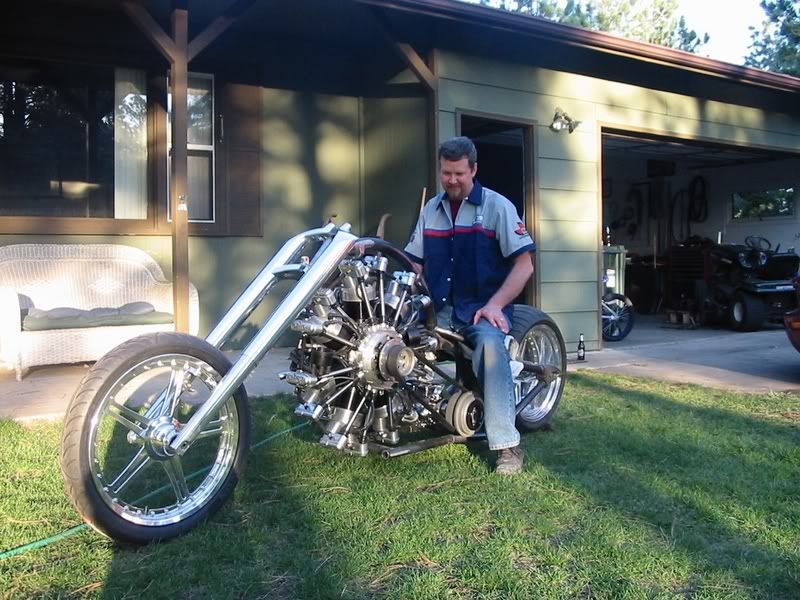I thought it might be interesting, if not prudent, to do a few calculations on the engine's power handling limitations. These calculation might be useful to others when it comes time to select a prop for their own radial. The first calculation is the maximum torque, from a materials perspective, that the crankshaft is capable of handling. In this engine the full power is transmitted to the propeller through the front crankshaft section. The average diameter of this section is .500", but there is a short portion just forward of the cam drive gear that is only .420" in diameter, and this is likely the weak point of the shaft. These first order calculations ignore any effects from stress risers in the corners left behind by machining as well as the 1/8" diameter PCV vent that was drilled through the front section.
The T-18 crankshaft is constructed from 12L14 steel which has a yield strength (tensile) of about 60,000 psi. Since the crankshaft is torsionally loaded it's the torsional yield strength that's of interest. This is typically estimated at 60% of the tensile value which, for 12L14, is about 36,000 psi.
From high school physics, a torque T (in-lbs) applied to a shaft of diameter d (inches) creates a torsional stress s (psi) according to the expression:
s = 16 * T / (pi * d^3)
The torque corresponding to the torsional yield stress at the crankshaft's weak point is:
T = s * pi * d^3 / 16
T = 36,000 * pi * .420^3 / 16
T = 523 in-lbs
T = 44 ft-lbs
This number is in line with the destructive test results I recorded earlier during the design of the crankshaft.
The T-18, being a display model, is run only under static conditions. That is, a prop is fitted to the crankshaft, and the engine is run while being fixed to a bench. As a result, a static thrust is generated by the prop which tries to pull the engine forward, and the crankshaft is loaded by the power creating this thrust. The amount of thrust is dependent upon the pitch and diameter of the prop, the engine rpm, and the air density. An online static thrust calculator such as the one located at:
http://personal.osi.hu/fuzesisz/strc_eng/ can be used to compute this thrust as well as the power generated by the engine. For example, with the current three blade, 28 x 12 prop running at 3500 rpm, this calculator predicts the engine will generate about 30 lbs of thrust and 3 hp. The horsepower can be easily converted into crankshaft torque using a well known equation relating the two:
Torque (ft-lbs) = HP * 5252 / RPM
While the engine is generating 3 hp at 3500 rpm the crankshaft torque is:
Torque = 3 * 5252 / 3500
Torque = 4.5 ft-lbs
which is an order of magnitude lower than the crankshaft's yield point. (NEMA standards use much larger safety factors for electric motors since they must contend with loads having high torque starting and stall conditions.)
The forward thrust which is totally supported by the engine's front bearing should also be considered. The T-18 crankshaft is designed so its loaded front section can move forward a few thousandths until a shoulder located just forward of the weak point contacts the inner race of the front bearing. This bearing is a generic 1/2" i.d. deep groove ball bearing. The axial load rating for these bearings is a complex quantity and is generally unspecified. An axial load pushes the balls up and onto the flat side of the race where the increased contact pressure and surface finish increase the probability of brinnelling. Conservative designers wishing to not impact bearing life with excessive axial loads will limit them to a few percent of the bearing's specified radial load. In this application, however, where dozens of hours of bearing life may be sufficient; an arbitrary 10% load factor may be acceptable. The radial load rating of the T-18 front bearing is 500 lbs which gives an arbitrary axial load rating of 50 lbs.
Shaft hp is a sensitive function of rpm in a statically loaded run. Using the same propeller, but running at 5000 rpm, the calculator predicts an increase in thrust to 60 lbs, and a shaft power of almost 9 hp. This level of output power is at the edge of any reasonable estimate of this engine's capability and is likely beyond the volumetric capacity of the existing carburetor. At this rpm and power level, though, the crankshaft torque increases to nearly 9.5 ft-lbs.
There is still almost a 5X safety factor at this increased level of torque, but it is common practice to maintain at least this level of margin to guard against second order effects such as fatigue and repetitive stress loading.
It is certainly possible to select a prop that will load the crankshaft dangerously close to its yield point even at a modest 3500 rpm. A three blade 36 x 16 prop is also available, and this prop will load the crankshaft with nearly 17 ft-lbs of torque in a static run. - Terry















